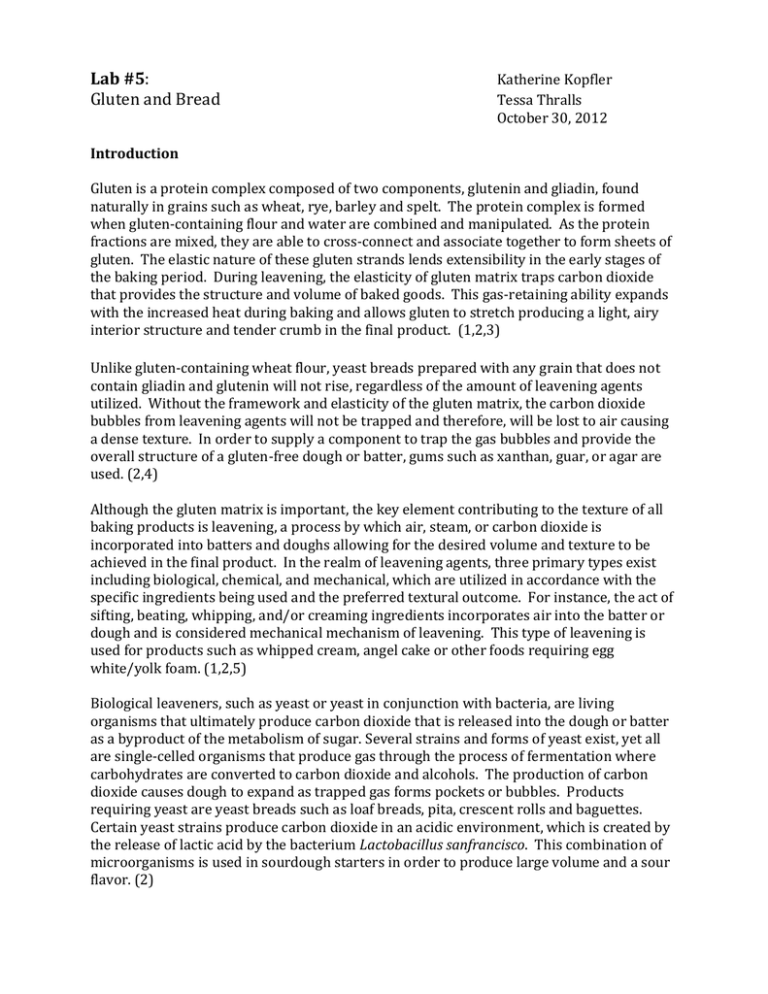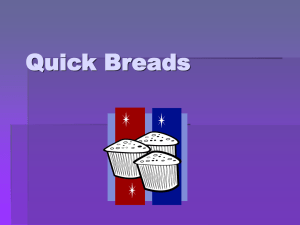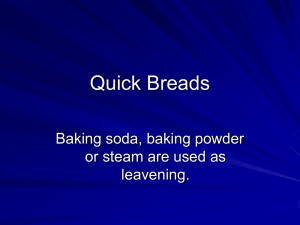
Lab #5:
Gluten and Bread
Katherine Kopfler
Tessa Thralls
October 30, 2012
Introduction
Gluten is a protein complex composed of two components, glutenin and gliadin, found
naturally in grains such as wheat, rye, barley and spelt. The protein complex is formed
when gluten-containing flour and water are combined and manipulated. As the protein
fractions are mixed, they are able to cross-connect and associate together to form sheets of
gluten. The elastic nature of these gluten strands lends extensibility in the early stages of
the baking period. During leavening, the elasticity of gluten matrix traps carbon dioxide
that provides the structure and volume of baked goods. This gas-retaining ability expands
with the increased heat during baking and allows gluten to stretch producing a light, airy
interior structure and tender crumb in the final product. (1,2,3)
Unlike gluten-containing wheat flour, yeast breads prepared with any grain that does not
contain gliadin and glutenin will not rise, regardless of the amount of leavening agents
utilized. Without the framework and elasticity of the gluten matrix, the carbon dioxide
bubbles from leavening agents will not be trapped and therefore, will be lost to air causing
a dense texture. In order to supply a component to trap the gas bubbles and provide the
overall structure of a gluten-free dough or batter, gums such as xanthan, guar, or agar are
used. (2,4)
Although the gluten matrix is important, the key element contributing to the texture of all
baking products is leavening, a process by which air, steam, or carbon dioxide is
incorporated into batters and doughs allowing for the desired volume and texture to be
achieved in the final product. In the realm of leavening agents, three primary types exist
including biological, chemical, and mechanical, which are utilized in accordance with the
specific ingredients being used and the preferred textural outcome. For instance, the act of
sifting, beating, whipping, and/or creaming ingredients incorporates air into the batter or
dough and is considered mechanical mechanism of leavening. This type of leavening is
used for products such as whipped cream, angel cake or other foods requiring egg
white/yolk foam. (1,2,5)
Biological leaveners, such as yeast or yeast in conjunction with bacteria, are living
organisms that ultimately produce carbon dioxide that is released into the dough or batter
as a byproduct of the metabolism of sugar. Several strains and forms of yeast exist, yet all
are single-celled organisms that produce gas through the process of fermentation where
carbohydrates are converted to carbon dioxide and alcohols. The production of carbon
dioxide causes dough to expand as trapped gas forms pockets or bubbles. Products
requiring yeast are yeast breads such as loaf breads, pita, crescent rolls and baguettes.
Certain yeast strains produce carbon dioxide in an acidic environment, which is created by
the release of lactic acid by the bacterium Lactobacillus sanfrancisco. This combination of
microorganisms is used in sourdough starters in order to produce large volume and a sour
flavor. (2)
A third mechanism of leavening is the reaction of an acidic and alkaline ingredient that
generates carbon dioxide, which expands in the product during baking. This type of
leavening is achieved by the chemical agents baking powder or baking soda in combination
with and an acidic ingredient such as tartaric acid or soured dairy. Food products
requiring chemical leavening are quick breads such as pancakes, waffles, and muffins. (2)
Many baking goods require a mixture of leavening agents including the creation of steam
during baking which can maintain or increase the pressure of the gas or air pockets already
in existence. Regardless, the goal of leavening is the expansion of the batter or dough
resulting in optimal textural properties such as crumb structure, cohesiveness, consistency,
and uniform distribution of cell pockets. (1,2)
Results/Discussion
Table 1: Focaccia Bread Results
Treatment
Baked
Height
(mm)
Color
1-white
2-cream
3-tan
4-brown
5-grey
Control (whole wheat
flour)
Whole Wheat Pastry
Flour
Crumb Structure
(Pore uniformity)
1-non-uniform
2-slightly uniform
3-enough uniform
4-almost uniform
5-uniform
Crumb Structure (Pore
Size)
1-large
2-slightly large
3-medium
4-slightly small
5-extremely small
4
Thick cell walls
15
2.5
2
17
2.3
2
3
16.7
1.5
1
bigger pores at top
2
Thin walls
83
quickly
fell
3.5
light brown
1
bigger pores at top
4
Bastyr's Gluten-free
Flour Mix1
12
2
4
consistent pores
throughout
3
Cup-4-Cup2
13
1
3
2.5
100g Chestnut Flour &
100g Chia Flour
12
4
dark grey
5
very close together
and all small
4
Bread Flour
Vital Gluten Flour
1Brown
Rice Flour, Potato Starch, Guar Gum, Tapioca Starch
brown rice flour, white rice flour, potato starch, tapioca starch, milk powder, and xanthan gum
2Cornstarch,
Table 2: Focaccia Bread Sensory Score Card
Treatment
Crumb
Cohesiveness
1-greatest force to
break
2-moderate force
to break
3-minimal force
to break
4-easily breaks
5-crumbles to
touch
Control (whole
wheat flour)
3
Whole Wheat
Pastry Flour
3
3
Bread Flour
Vital Gluten Flour
Bastyr's Glutenfree Flour Mix1
Cup-4-Cup2
100g Chestnut
Flour & 100g Chia
Flour
1Brown
Flavor
1-no bitter, no
sour, sweet and
salty
2-slighly bitter,
slightly sour
3-mild bitter, mild
sour
4-bitter
5-extremely bitter
and sour
2
Balanced, slightly
sour
1
Slightly salty,
earthy
1
Balanced, slightly
sweet
1
extremely tough,
gummy
1
Slightly umami
4
Crumbly
3
Yeasty, sour
2
3
Sour
2
5
Bitter, soapy
Crumb
Consistency
1-greatest
chews
2-high chews
3-moderate
chews
4-low chews
5-least chews
Preference
1-extremely
desirable
2-desirable
3-slightly
undesirable
4-moderately
undesirable
5-extremely
undesirable
3
Dense
2
3
1.5
4
1
1
extremely
elastic, springy
5
4
Falls apart in
mouth
2
Grainy
2
2.5
3
4
Rice Flour, Potato Starch, Guar Gum, Tapioca Starch
brown rice flour, white rice flour, potato starch, tapioca starch, milk powder, and xanthan gum
2Cornstarch,
The amount of protein (gluten) in the bread affected its volume, consistency and texture.
The gluten matrix formed from moisture and manipulation is able to trap CO2, which
causes the matrices to stretch, and results in thinner, more tender cell walls. So, the breads
with the most gluten should rise the most, be the least dense and the most tender. The
bread with the highest gluten content was made with vital gluten flour. It did rise the most
by far during the baking process (see Table 1), but it promptly fell resulting in a dense,
gummy product. Bread flour is made from the endosperm and the aluorene layer, so it has
the second most gluten. It rose slightly less than the pastry flour, but it did have larger
pores and thin cell walls. The result was tender and easy to chew. The whole-wheat flour
(control) rose the least out of the gluten-containing breads. This is expected because it
contains the wheat bran, which is high in fiber. Fiber is able to cut some of the gluten
strands resulting in less gluten and a reduced ability to trap CO2. It had small cells and the
end product was dense and chewy.
The gluten-free breads rose significantly less (2-5mm) than the gluten-containing breads.
They each contained a different kind of gum which aided in the rising process. Gums are
able to form structure and trap CO2 similar to the gluten matrix but not as well. The flour
containing xantham gum (Cup 4 Cup) rose the most (see Table 1) and had the largest cell
size. The other two gluten free flours: Bastyr’s blend and the chestnut/chia blend
contained guar gum and chia seeds, respectively. They both rose the same amount, but
Bastyr’s mix had larger pores and was much less dense of a product. It was more tender
and easier to chew.
Conclusion
The blend of chestnut and chia seed flour is an attractive gluten-free product because of its
nutritional value and the ratio of macronutrients present. Chia seed is a soluble fiber that
is beneficial for the gastrointestinal tract, may help lower cholesterol levels, and help
regulate blood levels. It is also high in omega-3 fatty essential fatty acids and essential
amino acids. Furthermore, many people have reported being sensitive to gums (xantham
gum or guar gum), so chia seed is a beneficial substitution for them in gluten-free baking.
In terms of chestnut flour, not only does it contain vitamin E, B vitamins, potassium,
phosphorous, magnesium, and high quality protein, but it also has a much higher
carbohydrate to fat ratio than other nut flours making it seem ideal for baking. In addition,
the ratio of macronutrients is similar to one diabetic exchange of carbohydrate suggesting
this may be a good product of diabetics. (6,7)
However, the result of the chestnut/chia blend focaccia bread made in class was less than
desirable. It did not experience substantial rise resulting in a dense, chewy product; also,
the flavor was unpleasant. One problem with the chestnut/chia bread flavor was the
extreme bitterness. Most gluten-free recipes do not call for quite as much chia seed flour.
Its use as a gum in gluten-free baking means that only a small amount of it is needed. Also,
in order to act as a gum and create more of a rise, the chia seed needs to be soaked in
boiling water before being added. (6)
In 2010, Demirkesen et al., studied different ratios of chestnut and rice flours with various
gum blends and emulsifiers. It was determined that gluten-free breads containing a
chestnut/white rice flour ratio at 30/70 with a blend of xanthan/guar gums and an
additional emulsifier (DATEM) resulted in higher quality ratings in term of volume,
hardness, color and sensory values. After further researching the emulsifier, it appears it is
commonly derived from GM soybean oil and therefore, is not suggested; although
considering an alternative could prove beneficial. White rice flour is high in carbohydrates
and low in fat, protein, and fiber. It contains moderate levels of manganese and trace
amounts of B vitamins, omega-6 fatty acids, phosphorus, and potassium. Comparatively,
chia seeds contain moderately high amounts of protein, fiber, omega-3 and omega-6 fatty
acids, calcium, manganese, phosphorus, potassium, and B vitamins. (7,8,9,10)
Rather than necessarily substituting the rice flour for chia flour, a recommendation that
may improve the bread is adding a small amount of tapioca flour to the chestnut/chia blend.
The tapioca flour has a high starch percentage that enhances the texture of gluten-free
baked goods. Also, the addition of tapioca flour would reduce the fiber percentage
provided by chestnut and chia seed. Although the fiber content of chestnut flour can
provide emulsifying, stabilizing, and thickening properties, it has the potential for
drawbacks such as low specific volume, firm texture, dark color and bitter taste when it is
used in excess. Fiber in high amounts has the potential to cut gluten strands and create a
dense texture, which could then be reduced by the addition of naturally low-fiber tapioca
starch. (7,8)
A suggested provision to the gluten-free chia/chestnut recipe includes increasing the
amount of chestnut flour to 170g, adding 25g of tapioca starch, and one tablespoon of chia
seed flour, and no guar gum. The one-tablespoon chia seed flour should be mixed with 2
tablespoons (30mL) boiling water and added it to the recipe with the wet ingredients. The
water content should be reduced by 30mL. Ideally the resulting baked product will have
greater volume, lighter texture, improved crumb consistency and a balanced flavor profile.
References
1) McWilliams M. Dimensions of Baking. In: Foods Experimental Perspectives. 7th ed.
Upper Saddle River, New Jersey: Pearson Prentice Hall; 2012:391-421.
2) Piccinin D. Food Science Lab 5: Gluten and Bread. Kenmore, WA: Bastyr University;
Fall Quarter 2012.
3) Corriher S. Cookwise. New York, NY: HarperCollins; 1997.
4) Gluten-Free Baking. Colorado State University Extension.
http://www.ext.colostate.edu/pubs /foodnut/09376.html. Accessed October 28,
2012.
5) Leavening agent. Wikipedia. http://en.wikipedia.org/wiki/Leavening_agent.
Accessed October 28, 2012.
6) Chia seeds and flaxseeds. Gluten-free girl and the chef.
http://glutenfreegirl.com/chia-seeds-and-flaxseeds/. Accessed October 28, 2012.
7) Demirkesen I, Mert B, Sumnu G, Sahin S. Utilization of chestnut flour in gluten-free
bread formulations. Journal of Food Engineering. 2010;101:329–336.
8) Sacchetti G, Pinnavaia G, Guidolin E, Dalla-Rosa M. Effects of extrusion temperature
and feed composition on the functional, physical and sensory properties of chestnut
and rice flour-based snack-like products. Food Research International. 2004;37:527534.
9) White rice flour nutrition facts. Self Nutrition Data. http://nutritiondata.self.com/
facts/cereal-grains-and-pasta/5726/2. Accessed October 28, 2012.
10)Chia seed nutrition facts. Self Nutrition Data. http://nutritiondata.self.com/
facts/nut-and-seed-products/3061/2. Accessed October 28, 2012.








